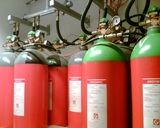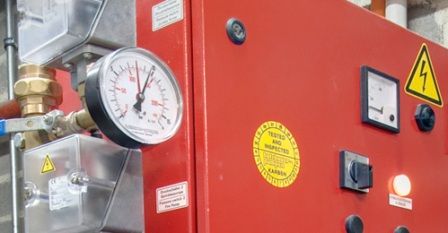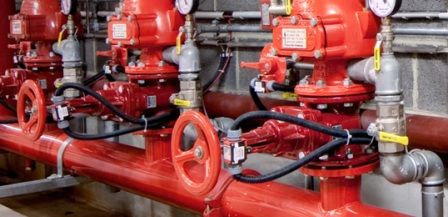Fire automation
 Fire automation is represented by a set of technical means with the help of which fire is detected, localized, extinguished and extinguished, as well as warn people about a fire. Automation independently (automatically) detects the source of ignition, notifies people, manages the evacuation of personnel and automatically extinguishes a fire with smoke removal. Also «fire management systems» can control all types of equipment located in objects and buildings.
Fire automation is represented by a set of technical means with the help of which fire is detected, localized, extinguished and extinguished, as well as warn people about a fire. Automation independently (automatically) detects the source of ignition, notifies people, manages the evacuation of personnel and automatically extinguishes a fire with smoke removal. Also «fire management systems» can control all types of equipment located in objects and buildings.
The effectiveness of the installation of fire protection automation is influenced by many factors, the main of which is the correctly selected means for fire protection automation. Fire automatic equipment automatically detects fire, notifies people about fire, etc. They are represented by fire detectors, fire control devices, fire control devices, fire technical means of warning and evacuation, fire transmission systems, other devices and equipment with the help of which fire automation is built.
There is no doubt that effective fire control systems are one of the most important indicators of fire safety, therefore the type of installation is also of great importance.

Types of fire automation installations
• Water fire automatic installations
They are the most common and are used in hotels, shopping centers, hydroelectric plants, etc. Sprinkler installations are designed for local fire extinguishing, as well as for cooling structures. Often these installations can be found in rooms where there is a possibility of fire, where there will be intense heat generation.
The main disadvantages: there is no possibility of detecting a fire at an early stage and a lot of work involved in restoring the original state. Pros for installation: ease of use, low cost, and automatic triggering. Plumbing installations do not have thermal locks, while they are equipped with fire detection devices to give a signal to start extinguishing a fire.
• Foam automation systems
As a rule, they are used to extinguish flammable and combustible liquids in containers, combustible substances, as well as petroleum products that are inside and outside buildings. Foam discharge devices are used in local areas of buildings, transformers, electrical devices. Immersion and spraying installations have a fairly similar purpose and device, only foam differs in the presence of a container with foam concentrate and dosing devices during the separate storage of fire extinguisher elements, as well as the use of foam generators and sprinklers.
Disadvantages: difficult fire extinguishing in rooms with electrical installations, difficult maintenance, dependence on water supply, extensive damage to the building.
• Fire extinguishing with water mist
Principle of operation: uniform distribution of water over the protected volume and area due to the creation of a finely dispersed flow, which makes it possible to use these sprinklers for libraries, warehouses, etc., where the water damage caused by conventional installations is no more - somewhat large from fire damage.
• Automatic fire extinguishing equipment
It is used for extinguishing fires of classes A, B and C, as well as for electrical equipment. This fire automation of buildings and facilities is subdivided according to the method of extinguishing, according to the method of storing the gaseous substance and according to the method of switching on the extinguishing.
• Installations for powder fire extinguishing
They are used to extinguish fires of electrical equipment under voltage and fires of classes A, B and C. It is possible to use such installations in premises where there is a mass stay of people, for example, a theater, shopping centers. However, these plants do not stop burning completely. Powder installations, depending on the device of the fire extinguishing element, may or may not have a distribution pipeline. And depending on the gas storage in the tank, they are injection, with gas generating elements, with bottles of liquefied or compressed gas.
• Aerosol fire extinguishing
It is used for extinguishing class B and subclass A2 fires.It is possible to use these installations in rooms with combustible materials, the combustion of which can be referred to subclass A1, also for cable structures (half-floors, collectors, mines), provided that the electrical networks do not have automatic restart. Approval for the use of aerosol fire extinguishing installations in rooms with cables, electrical installations and electrical equipment is possible only if the voltage is not higher than the maximum permissible value specified in the technical documentation.

Fire automation service
It is a set of processes related to maintaining the operability of devices during operation, standby, storage and transportation. Maintenance is represented by a set of works that provide control over the technical condition of installations, keeping them in good condition and expanding their characteristics.
Maintenance of fire automation includes organizational issues, maintenance rules and methods of verifying correct operation. The responsibility for the implementation of the rules for the maintenance of fire automation rests with the heads of enterprises.
After the commissioning of fire-fighting automation installations, the head of the enterprise appoints persons who will be responsible for the operation of the automation. Large enterprises create dedicated teams and support teams. For round-the-clock monitoring of the operability of the fire automation, on-duty employees are involved. Maintenance personnel carry out repair and maintenance of installations, maintain them in working order, maintain operational documentation.
